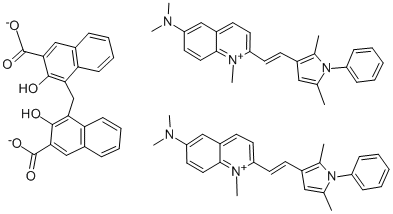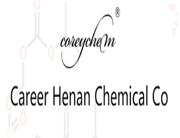| Pharmacology and mechanism of action |
Pyrvinium is a quaternary ammonium derivative of a cyanine dye with marked effect against Enterobius vermicularis.
The mechanism of action is not well known. The drug inhibits oxidative metabolism in the worms and interferes with the absorption of glucose in intestinal helminths. Since most intestinal worms are dependent on anaerobic carbohydrate metabolism, this may be an important action of the drug[1].
|
| Indications |
Infections caused by Enterobius vermicularis. Pyrvinium is largely replaced today by more effective and safer drugs such as albendazole and mebendazole.
|
| Side effects |
Gastrointestinal disturbances such as nausea, vomiting, dyspepsia, indigestion and abdominal pain are frequent. Allergic reactions and photosensitivity have been reported. Pyrvinium stains the stool bright red and may stain clothing if vomiting occurs. Patients should be informed about this.
|
| Preparations |
Pyrvinium pamoate (embonate): 450 mg of the pamoate is equivalent to 300 mg of pyrvinium.
• Povanyl ® (Parke-Davis). Oral solution 10 mg pyrvinium per ml. Tablets 50 mg pyrvinium.
• Vanquin® (Parke-Davis). Oral solution 10 mg pyrvinium per ml. Tab pyrvinium. |
| References |
1. Buchanan RA, Barrow WB, Heffelfinger JC, Kinkel AW, Smith TC, Turner JL (1974). Pyrvinium pamoate. Clin Pharmacol Ther, 16, 716–719. |
| Uses |
anthelmintic |
| Brand name |
Povan (Parke-Davis). |
| General Description |
Odorless bright orange or orange-red to brownish red or almost black fluffy powder. Melting point 210-215°C. Insoluble in water. Tasteless. |
| Air & Water Reactions |
Insoluble in water. |
| Reactivity Profile |
PYRVINIUM PAMOATE is light sensitive. Incompatible with strong oxidizing agents, strong acids and bases . |
| Fire Hazard |
Flash point data for PYRVINIUM PAMOATE are not available; however, PYRVINIUM PAMOATE is probably combustible. |

 China
China





